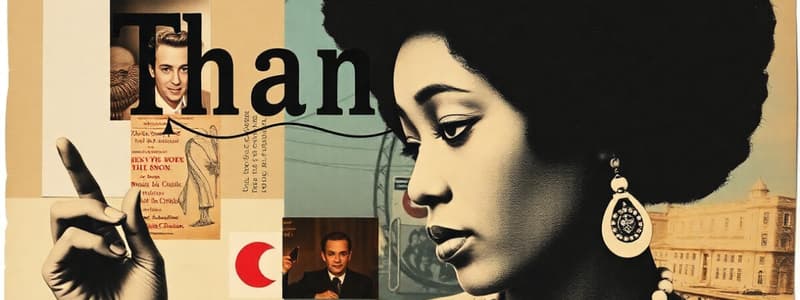Podcast
Questions and Answers
What does Mrs. Jones imply about her past when she mentions being young and wanting things she could not get?
What does Mrs. Jones imply about her past when she mentions being young and wanting things she could not get?
- She wishes she had remained single.
- She understands the boy's desires and struggles. (correct)
- She believes all young people should face consequences.
- She regrets not stealing when she was young.
How does Mrs. Jones demonstrate forgiveness towards Roger after he attempted to snatch her pocketbook?
How does Mrs. Jones demonstrate forgiveness towards Roger after he attempted to snatch her pocketbook?
- She scolds him harshly.
- She ignores him completely.
- She turns him over to the police.
- She offers him food and a chance to talk. (correct)
What action does Roger consider but ultimately refrain from after washing his face?
What action does Roger consider but ultimately refrain from after washing his face?
- Running away from the woman's home. (correct)
- Asking for more money.
- Stealing her food.
- Apologizing to Mrs. Jones.
What lesson might Roger be learning from his interaction with Mrs. Jones?
What lesson might Roger be learning from his interaction with Mrs. Jones?
What does Mrs. Jones likely expect Roger to do after sharing her personal experience with him?
What does Mrs. Jones likely expect Roger to do after sharing her personal experience with him?
What lesson does Mrs. Jones emphasize through her interaction with the boy?
What lesson does Mrs. Jones emphasize through her interaction with the boy?
Which action reflects the character development of the boy during his time with Mrs. Jones?
Which action reflects the character development of the boy during his time with Mrs. Jones?
How does Mrs. Jones's attitude towards the boy affect his perception of personal responsibility?
How does Mrs. Jones's attitude towards the boy affect his perception of personal responsibility?
What does Mrs. Jones give to the boy that represents both forgiveness and a chance for redemption?
What does Mrs. Jones give to the boy that represents both forgiveness and a chance for redemption?
What does the boy’s inability to express gratitude at the door suggest about his emotional state?
What does the boy’s inability to express gratitude at the door suggest about his emotional state?
Flashcards
Boy's initial hesitation
Boy's initial hesitation
The boy initially hesitated to ask for help, but then decided to do so.
Woman's offering of help
Woman's offering of help
The woman offered to help the boy by providing food and shoes.
Woman's compassion
Woman's compassion
Despite the boy's unknown background, the woman demonstrated compassion and empathy.
Boy's request for help
Boy's request for help
Signup and view all the flashcards
Woman's job
Woman's job
Signup and view all the flashcards
Woman's generosity
Woman's generosity
Signup and view all the flashcards
Financial gift
Financial gift
Signup and view all the flashcards
Boy's gratitude
Boy's gratitude
Signup and view all the flashcards
Woman's advice
Woman's advice
Signup and view all the flashcards
Mrs. Jones's Actions
Mrs. Jones's Actions
Signup and view all the flashcards
Boy's Response
Boy's Response
Signup and view all the flashcards
Woman's Motivation
Woman's Motivation
Signup and view all the flashcards
Boy's Plea and Shoes
Boy's Plea and Shoes
Signup and view all the flashcards
Woman's Understanding
Woman's Understanding
Signup and view all the flashcards
The Event
The Event
Signup and view all the flashcards
Study Notes
Summary of "Thank You, Ma'am"
- Setting: Eleven o'clock at night, a city street.
- Characters: A large woman, and a young boy.
- Inciting Incident: The boy tries to steal the woman's purse, but the strap breaks and he falls.
- Confrontation: The woman, after kicking the boy, picks him up, shakes him, and demands the return of her purse.
- Question and Response: The woman asks why the boy tried to steal, and the boy replies "I didn't aim to". The woman calls his innocence a lie.
- Further Questioning: The woman asks if he will run if she releases him. Boy says yes. Woman responds that she won't.
- Interaction: The woman doesn't let him go. The boy is apologetic.
- Observation: Several witnesses observe the encounter.
- Action: The woman takes the boy inside, washes his face, and offers him food.
- Lesson: The woman teaches the boy about right and wrong behaviour, and the value of honesty.
- Outcome: The woman provides food and guidance, not punishment.
Key Themes
- Compassion and empathy: The woman shows kindness and understanding despite the boy's wrongdoing.
- Second chance: The woman provides a second chance for redemption.
- Social inequality: The story implicitly highlights the challenges faced by young people.
- Respect and responsibility: The story emphasizes the importance of respect and personal responsibility.
Key Events
- The boy attempts to steal the woman's purse.
- The woman confronts and takes control of the situation.
- The boy expresses regret and remorse.
- The woman takes the boy home and provides him with food and care.
- The woman educates the boy about proper behaviour.
Studying That Suits You
Use AI to generate personalized quizzes and flashcards to suit your learning preferences.




